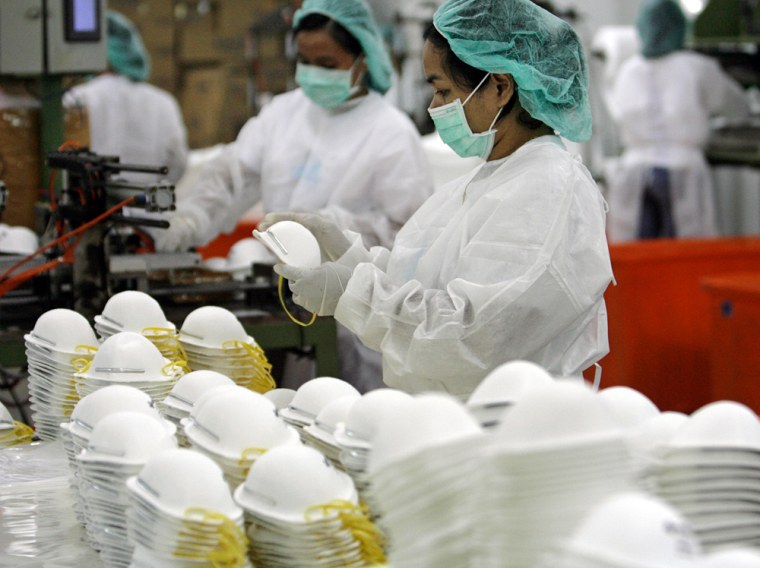The outbreak of the H1N1 influenza strain (otherwise known as the ickier-sounding "swine flu") has major political and public-health ramifications, but it's also causing agita for the business sector.
While there's still a lot of uncertainty about the global spread of H1N1 — can it be contained? will it grow deadlier as it mutates? — there are some market precedents that offer a clue about how commerce and industry might be affected. The SARS outbreak that swept Asia in 2002 and 2003, as well as the more recent cases of avian flu in 2006, offer some insights.
TBM takes a look at which industries stand to win and lose from the would-be pandemic.
Winners
Pharmaceuticals. Someone could (ahem) make a killing here. Companies racing to develop a vaccine against the flu have two significant hurdles: They've got to manufacture a drug that targets the specific H1N1 strain, and they've got to get rid of vaccine producers' use of chicken eggs. Currently, manufacturers depend on eggs to cultivate the vaccine. Not only does that require a lot of eggs; it also takes a long time. This is why annual flu shots don't always protect you from getting the flu; scientists have to guess months in advance which strains are going to be in circulation, and they don't always get it right.
Thanks to the H1N1 scare, the FDA is likely to face intense pressure to green-light the first new vaccine method that comes down the pipeline, which means that method will be the go-to for this winter's flu vaccine, too. It will be a very lucrative position for the company that gets it right; the contenders are Novartis, Baxter Pharmaceuticals, and GlaxoSmithKline.
There's also the question of Tamiflu: Although scientists say the drug isn't a silver bullet against this strain, if the H1N1 outbreak turns into a full-blown pandemic (which seems increasingly likely), Swiss drug company Roche Holding AG could stand to benefit. Although there are pretty decent stockpiles of Tamiflu already in the system, panic-driven hoarding could drive up demand in the future, giving a boost not only to Roche but other companies that manufacture antiviral drugs.
Drug Stores. This flu scare is a shot in the arm for at least one subsection of the ailing retail industry. As consumers rush to pharmacies to stock up on Tamiflu as well as items like surgical masks and hand sanitizer (whose antibacterial properties, it should be noted, have absolutely no effect on the flu virus), chain drug stores are seeing their stock rise literally and figuratively. CVS Caremark and Walgreen are both having a good week.
Their bump could come at the expense of other retail sectors, though. Particularly if the flu outbreak widens and public fear spreads, consumers are likely to shy away from congregating in large public spaces, including shopping malls. Analysts predict spending could drop accordingly. According to World Bank research, the financial impact of SARS in East Asia totaled up to $25 billion, a figure almost entirely made up of reduced consumer demand due to fear rather than loss of productivity caused by the illness itself.
The losers
Pork. Although they've succeeded (somewhat) in getting the media to embrace the hog-neutral moniker of H1N1, and although there is absolutely no evidence that eating pork can infect a human, it seems that U.S. pork farming has drawn the short straw here. Hog prices plummeted 15 percent in the first three days of this week, and longer-term prospects are also grim.
Despite media reports of American consumers shunning pork products, this really isn't the heart of the problem. Even if there were a clear link between ham and H1N1, people aren't easily scared away from staple foods. According to data from market research firm NPD Group, during the avian flu outbreak, consumption of chicken was essentially flat.
At issue here are a couple of international trade issues. Any way you slice it, Mexico's tourism-dependent economy is going to take a pretty serious hit. Mexico imports one-fourth of all the pork exported by the U.S. If its economy—in which tourism has already been damaged by warnings about drug violence — slides into a free fall, big American pork outlets like Smithfield Foods are going to have a lot of extra bacon on their hands.
Another problem is countries using the H1N1 outbreak as an end run around tariff restrictions. Whether couched as protectionism or political chest-thumping, the bottom line is that bans like those imposed by China and Russia on U.S. pork exports add up to yet more excess meat for producers to unload.
The only way to get rid of all this extra pork is by slashing prices and cutting production if the slump in demand drags on. Ordinarily, the blowback from a longer-term reduction in supply would hit the grain industry hard, but the market for corn, soybeans, and the like is expected to remain high because of U.S. and EU mandates for biofuel usage, which consumes these crops as raw material.
Travel. Over the CDC's protestations, some European countries issued warnings against travel to Mexico and, in some cases, the United States as well. Already plagued with falling passenger and occupancy rates, this is the last thing airlines and hotels need. When SARS swept Singapore in late 2002 and early 2003, the number of visitors dropped by 74 percent and hotel occupancy dropped to 25 percent. (Most hotels need an occupancy rate of around 60 percent to break even.)
Analysts say Mexico will be impacted most severely, but H1N1 isn't going to do the U.S. travel industry any favors, either. Continental and American, two airlines with hubs in Texas that run a lot of flights to and from Mexico, are likely to feel the brunt of large-scale governmental or corporate travel restrictions if they have to cut their number of flights. Ancillary businesses such as restaurants and car rental outlets also will be hurt by decreased corporate and leisure travel.
